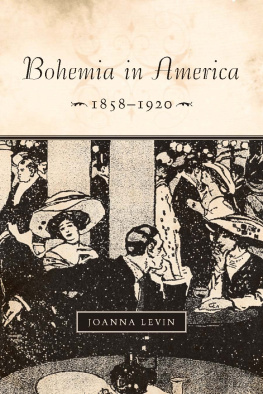Cottom - International Bohemia
Here you can read online Cottom - International Bohemia full text of the book (entire story) in english for free. Download pdf and epub, get meaning, cover and reviews about this ebook. City: Philadelphia, year: 2013, publisher: University of Pennsylvania Press, genre: Religion. Description of the work, (preface) as well as reviews are available. Best literature library LitArk.com created for fans of good reading and offers a wide selection of genres:
Romance novel
Science fiction
Adventure
Detective
Science
History
Home and family
Prose
Art
Politics
Computer
Non-fiction
Religion
Business
Children
Humor
Choose a favorite category and find really read worthwhile books. Enjoy immersion in the world of imagination, feel the emotions of the characters or learn something new for yourself, make an fascinating discovery.

International Bohemia: summary, description and annotation
We offer to read an annotation, description, summary or preface (depends on what the author of the book "International Bohemia" wrote himself). If you haven't found the necessary information about the book — write in the comments, we will try to find it.
International Bohemia — read online for free the complete book (whole text) full work
Below is the text of the book, divided by pages. System saving the place of the last page read, allows you to conveniently read the book "International Bohemia" online for free, without having to search again every time where you left off. Put a bookmark, and you can go to the page where you finished reading at any time.
Font size:
Interval:
Bookmark:
International Bohemia
BOHEMIA

Scenes of Nineteenth-Century Life
DANIEL COTTOM

A volume in the Haney Foundation Series, established
in 1961 with the generous support of Dr. John Louis Haney.
Copyright 2013 University of Pennsylvania Press
All rights reserved. Except for brief quotations used for
purposes of review or scholarly citation, none of this book
may be reproduced in any form by any means without
written permission from the publisher.
Published by
University of Pennsylvania Press
Philadelphia, Pennsylvania 19104-4112
www.upenn.edu/pennpress
Printed in the United States of America on acid-free paper
10 9 8 7 6 5 4 3 2 1
Library of Congress Cataloging-in-Publication Data
Cottom, Daniel.
International bohemia: scenes of nineteenth-century life / Daniel Cottom.
p. cm.(Haney Foundation series.)
Includes bibliographical references and index.
ISBN 978-0-8122-4488-5 (hardcover : alk. paper)
1. Bohemianism in literature. 2. BohemianismHistory19th century. 3. BohemianismHistory20th century. 4. Alternative lifestylesHistory19th century. 5. Alternative lifestylesHistory20th century. I. Title. II. Series: Haney
Foundation series.
PN56.B63 C68 2013
809'.933552dc23
2012041245
For Sharon Leslie, bohmienne
In this book I am concerned with how the vagabond word bohemia migrated across various national borderlines over the course of the nineteenth century and, in doing so, was developed, transformed, contested, or rejected. I focus on how individuals and groups sought to take possession of this word and make it serve as the basis for the elaboration of identities, passions, cultural forms, politics, and histories that they wanted to bring to life. With a nod to Henry Murger, whose Scenes of Bohemian Life was the closest thing the century had to a Bible of bohemian types and tropes, one might think of my work here as looking in on scenes from the life of a word. I begin with the invention of the modern sense of this word in Paris during the 1830s and 1840s and then trace some of its most important twists and turns, through the rest of this era and into the early years of the twentieth century, in the United States, England, Italy, and, to a lesser extent, Spain and Germany.
This is not a survey or general history, and I do not make any claims to comprehensiveness. I have chosen the individuals, works, scenes, and episodes to which I turn my attention here simply because I found them especially rewarding for thinking through the bohemian phenomenon. These do, however, cumulatively serve to represent what I take to be the most important aspects of the career that this much-debated word eventually came to have. The topics I address include the figure of the Jew in bohemia, the cultural politics of masquerade, capitalism, the political economy of art, the gospel of work, the nature of community, the question of the parasite, the intersections of race and class, the representation of women, the designs of modern desire, and the value of nostalgia.
Even when they traveled under the banner of lart pour lart, the bohemians of this era generally saw little reason to observe borderlines between their life and their art. On the contrary, they were eager to mix up the one with the other, and their critics often reproached them on this account, as when they claimed that bohemians were all talkdo-nothings frittering away their lives in cafs and taverns. To help draw out the implications of this feature of bohemianism, I have woven into my arguments in this book discussions of the lives of several notable figures: Thomas Chatterton, George Sand, George Eliot, Murger, Alexandre Privat dAnglemont, Walt Whitman, Ada Clare, Iginio Ugo Tarchetti, and Arthur Conan Doyle.
A note on orthography: except when quoting others, I have reserved Bohemia, with a capital letter, for the Eastern European country of that name, and have used bohemia for the modern cultural formation. Translations not otherwise noted are my own.
Much later, Madame Aurore Dudevant would say that her transvestism was nothing more than a practical expedient, a matter of common sense. As an adolescent, she had been permitted to dress in masculine attire to go riding. When she began to appear in public dressed as a man, in 1831, she did so because she had moved to Paris and quickly found the city to be hell on a ladys wardrobe, soiling and spoiling it at a terrifying rate. She might have avoided the problem by spending more of her time at home, but she had come to this city to get out into the world, not to shut herself away from it. Now that she was separated from her husband and living on her own, she needed to keep a close eye on her expenses; and wearing mens clothing, she realized, would be much cheaper than trying to maintain her finery. She claimed to have gotten the idea from her mother, who remembered how she and her sister had adopted this expedient when they were thrifty young wives who wished to go out with their husbands.
As she remembered it, the plan worked like magic. I flew from one end of Paris to the other. It seemed to me that I might have gone round the world.
More than a decade after Sands sartorial transformation, Rosa Bonheur pleaded the exigencies of her artistic labors when she sought and was granted legal permission to wear mens clothing. (Her Permission de Travestissement was officially issued by the police for reasons of health.)
If this story was plausible, it is also true that Sand had considerable experience in the invention of plausible stories by the time that she came to tell it. In any case, even if her motivations had been as simple as she claimed, her cross-dressing still would not have appeared to the world at large as nothing more than a sign of economic prudence in an earnest young person seeking to learn how to succeed in her chosen profession. Instead, with good reason, it became an iconic image of bohemian provocation.
Looking back on the image of her youthful transvestism, Sand wanted her public to see an ingenuous provincial, newly arrived in the city, seeking to support herself and her children as well as she could. Today, however, as in her own era, the image is more likely to evoke a sense of the artistic freedom that Sand celebrated in her life and words. No doubt the young Sand had found it necessary to keep her accounts, as would any good grocerto use the scornful term, picier, that she and other bohemians employed when they wished to mock a member of the bourgeoisie. Nonetheless, she had also found opportunities for revels. She would later remember, for instance, a fantastic moonlit promenade across the Latin Quarter with one of her lovers, Jules Sandeau, her editor at Le Figaro, Henri Delatouche, and a friend, Flix Pyat, during which Pyat stopped at every store they passed to serenade the proprietors with his full-throated rendition of A grocer is a rose. In the passage about this adventure in her History of My Life (185455) Sand does not record what clothes she was wearing on this particular evening, but anyone can see how her habit of masquerade might have graced this occasion, as it did so many others.
But it was not only through irregular dress or habits, such as smoking in public, that Sand made herself a bohemian. Along with Pyat, who wrote of bohemians in a notable essay, she was one of those who played a crucial role in redefining this term during the 1830s, preparing it for the lasting fame it would acquire through the stories of Henry Murger in the following decade. In contrast to Pyats caustic account of bohemian artifice, Sand portrayed the bohemian as an artistic wonder. Between them, they framed a future for a signifier of marginality that would be central to the articulation of modernity not only in France but internationally.
Next pageFont size:
Interval:
Bookmark:
Similar books «International Bohemia»
Look at similar books to International Bohemia. We have selected literature similar in name and meaning in the hope of providing readers with more options to find new, interesting, not yet read works.
Discussion, reviews of the book International Bohemia and just readers' own opinions. Leave your comments, write what you think about the work, its meaning or the main characters. Specify what exactly you liked and what you didn't like, and why you think so.




